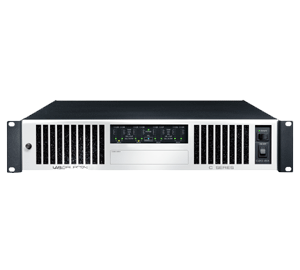모델명 :
|
<이미지를 클릭하시면 큰사이즈로 보실 수 있습니다.>
|
||||||||||||||||||||||||||||||||||||||||||||||||||||||
The C 20:8X is the largest 8-channel amplifier in the C Series family, delivering an impressive 8 x 250 W* at 4 ohms, 8 ohms, 16 ohms or 70 Vrms (500 W at 100 Vrms is available by bridging two channels) from a 2U chassis.
C 20:8X Series amplifiers are uniquely capable of adapting to a wide variety of demanding load conditions. Each channel has an individually configurable Voltage Peak Limiter (VPL), which allows the output to be optimized for any loudspeaker load ? whether a single large subwoofer or a series of small 70 V loudspeakers (100 V in bridge mode). VPL works in combination with adjustable input gain (adjustable in 4-channel blocks) to achieve maximum headroom regardless of input levels or output impedances. Additionally a 35 Hz high pass filter may be inserted in each 4-channel section.
Every C Series amplifier is ready for the NomadLink® network right out of the box. With NomadLink®, key amplifier parameters are displayed via DeviceControl PC software, and remote control of channel mutes and power on/off is under network control.
* Maximum continuous output power, all 8 channels driven, VPL set at 100 V and Gain set at 32 dB.
Class TD and PSU
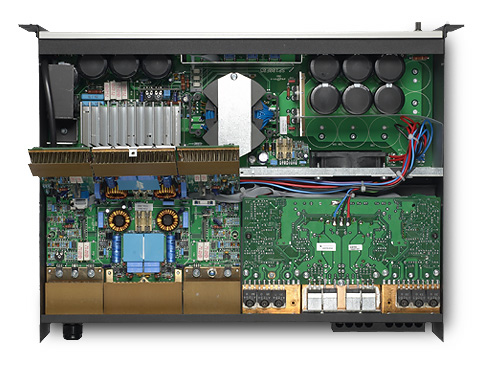
Class TD
Patented Class TD topology ? a masterpiece of design - utilizes a sonically high quality Class B stage for the audio signal passing directly to the speakers and a high frequency tracking rail voltage provides the high efficiency known from Class D topology. This combination produces a flat frequency response into reactive loads, and does not color the sound in any way.
With the introduction of C Series, Class TD has now been taken to another level and, for the first time, is made available in a package 100% dedicated to the special requirements of permanent installations.
The super-efficient Class TD amplifier modules are coupled to an optimized Regulated Switch Mode Power Supply (R.SMPS). R.SMPS, being regulated, ensures the amplifier will deliver stable output power independent of deviations in the mains voltage. So, with C Series you do not worry about getting less power from the amplifier if the voltage drops.
These two key components together provide three major benefits: Efficient high-power output, consistent and reliable operation and natural, uncolored sound.
To discover more about the core Lab.gruppen amplifier and PSU technologies, please review the Technology Brief entitled “Class TD, Regulated SMPS, and Intercooler®” available in the “Documentation” area of this website.
Signal flow
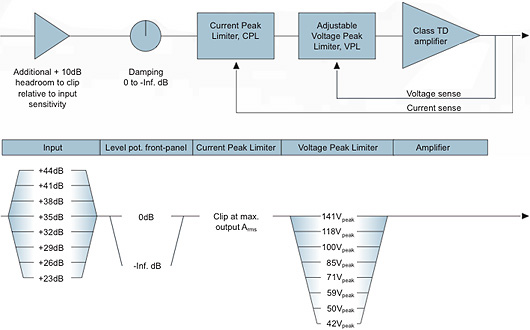
Overall amplifier gain and input sensitivity is adjustable in eight steps from +23 dB to +44 dB via three rear-panel-mounted DIP switches making it possible to match the amplifier with any input source device. Individual channel gain is adjustable in 3 dB increments from 0 dB to -infinity via four front-panel-mounted level potentiometers that are located below the indicators and behind the detachable front panel grille, which effectively serves as a security cover.
The Voltage Peak Limiter (VPL) is fully user-adjustable providing the unique option of selecting maximum output peak voltage and thereby the maximum output power. This is convenient when using the amplifier to drive speakers with different power requirements, and when connecting to constant voltage systems requiring e.g. 70 V. Eight individual output voltage levels are available.
The Current Peak Limiter (CPL) protects amplifier and power supply modules, and the loads the amplifier is driving, from damage. Following the input gain, VPL and CPL circuitries, a number of other important monitoring and protection features are provided. These include voltage, current, and temperature monitoring and control.
C Series amplifiers are a lasting investment. Designed and built in the tradition that has made Lab.gruppen world-famous among leading tour sound companies, C Series is an icon for reliable amplification and guarantees long-term quality performance.
Lo Z and 70V/100V
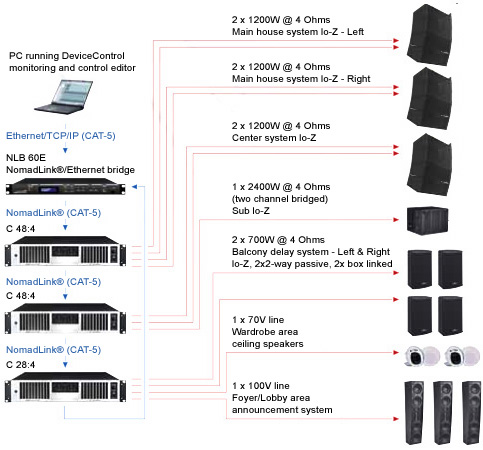
Permanent installation applications most often require a mix of Lo- and Hi-Z (constant voltage) speakers.
For instance, the main house system could be a full-range or actively crossed over multi-way system, while the speakers for peripheral areas may be small line-source boxes and ceiling speakers.
Using C Series amplifiers you are able to connect any type of speaker to any output channel by adjusting the Voltage Peak Limiter (VPL), thus supplying the desired maximum output power or maximum constant voltage supply.
There is no need to buy specific amplifiers for constant voltage and Lo-Z loads and no need for additional external transformers.
The C Series amplifiers' 4- or 8-channel configurations, bridge-mode operation, and the ability to mix Lo-Z and constant voltage outputs with the same amplifier, make the C Series extremely flexible and user-friendly ? both, during the design process and after installation is complete.
For constant voltage lines C 68:4, C 48:4, C 28:4 and C 16:4 are capable of providing up to 4 channels of 100 Vrms or 2 channels of 200 Vrms at various levels of maximum power. C…X models are configured to provide a fixed power output no matter if the impedance is 4 ohms, 8 ohms, 16 ohms or 70 Vrms (100 Vrms is available by bridging two channels).
Voltage Peak Limiter
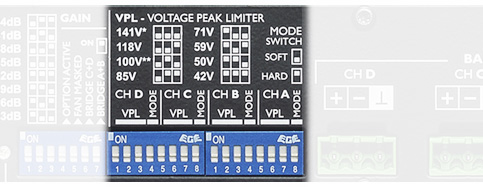
The Voltage Peak Limiter (VPL) is a key feature in C Series' versatility. DIP switches enabling the selection of eight different maximum output voltage levels open a world of opportunities when scaling the outputs to match different target speakers.
The output scaling per channel ranges from 141 Vpeak down to 42 Vpeak on all models. When bridging two channels the maximum output voltage doubles.
The peak limiter mode is adjustable between hard and soft operation per channel. Hard may be selected when you are likely to hit the amplifier's limits, e.g. in subwoofer applications.
The most obvious benefit of the adjustable VPL is that a very small number of different amplifier models offer greatest variety for the system designer. During the installation process the various outputs are then set according to design specifications and desired performance.
This way the four C Series models cover a much wider range of available output power ratings than the technical specifications might indicate at first glance.
Amplifier Gain
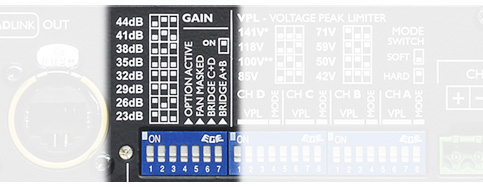
The overall gain of C Series amplifiers can be adjusted from 23 dB to 44 dB in 3 dB increments. Changing the gain alters the amplifier's sensitivity, that is: How much input level in Vrms is required to provide maximum rated output power to the connected load? The higher amplifier gain, the higher the sensitivity, meaning the lower value in Vrms is required input signal to reach maximum output power.
Adjusting gain - or sensitivity, respectively - should be utilized to optimize the ratio of amplifier headroom to noise floor. At higher gains (higher sensitivity) more of the noise floor will be amplified and the headroom before clip will be lower.
Having the ability to adjust gain and sensitivity on-board makes it very easy to match C Series amplifiers with any combination of input devices and output loads.
Bridge-mode operation
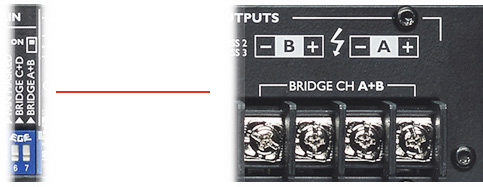
Having four or eight channels available per amplifier suddenly puts bridge-mode operation into a completely new context. As an example, the C 68:4 would give you two channels of 1700 W and one channel with 2400 W into 4 ohm loads.
Usually, bridging a power amplifier causes the amplifier gain to raise by 6 dB; hence, it often makes users believe that the amplifier delivers "more than twice the power", when in fact it is just additional gain.
C Series amplifiers automatically compensate for this phenomenon by introducing a gain reduction of -6 dB, therefore maintaining the same gain settings for all channels making it very simple to specify and align speakers.
Bridge mode is easily configured via DIP switches on the rear panel. Any two channels can be bridged independently. Input channels A and C (or A, C, E and G with 8-channel models) would be used to provide signal for the bridged channels.
Remote Power On/Off
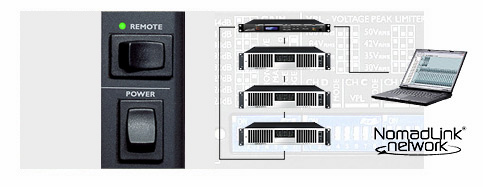
In fixed installations the amplifiers are often located far away from the control room. For this and other reasons (e.g. safety regulations) the ability to remotely power on/off the amplifiers is a requirement. While expensive external power sequencers can do the job, C Series amplifiers with their on-board NomadLink network have this functionality built in, saving a significant amount of money in the total installation project.
Adding the NLB 60E unit to the system provides local and remote amplifier control via the NomadLink network and supplies phantom power to power up the amplifiers.
Directly accessible subnet power on/off buttons are located on the front panel of the NLB 60E and, if a PC is connected using Ethernet, you are able to group individual amplifiers that can be powered up together. Groups can even be created across several subnets and NLB 60Es with the DeviceControl Editor software.
The NomadLink network control ensures that the amplifiers to not consume any power while switched to stand-by mode. Only the NLB 60E must be powered continuously to maintain network communication.
